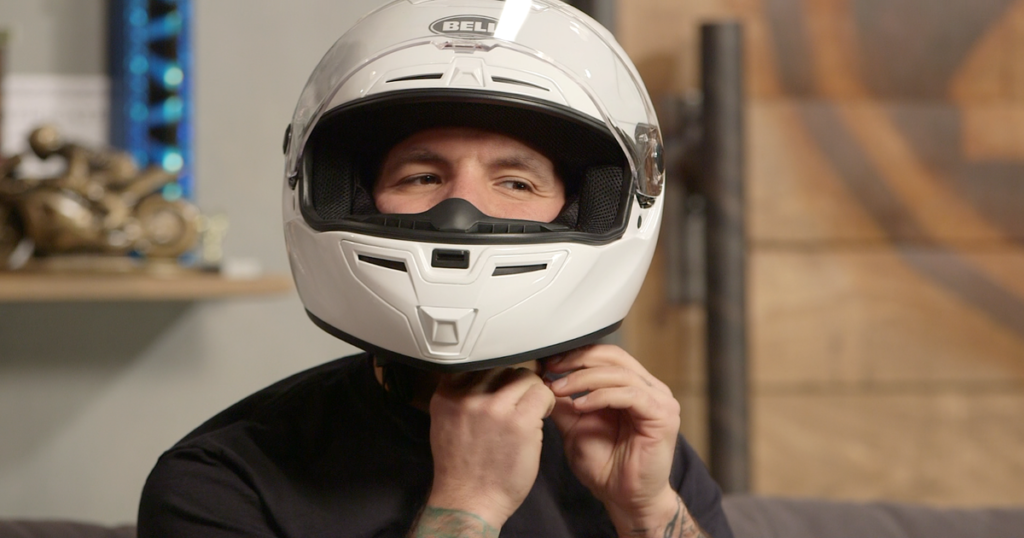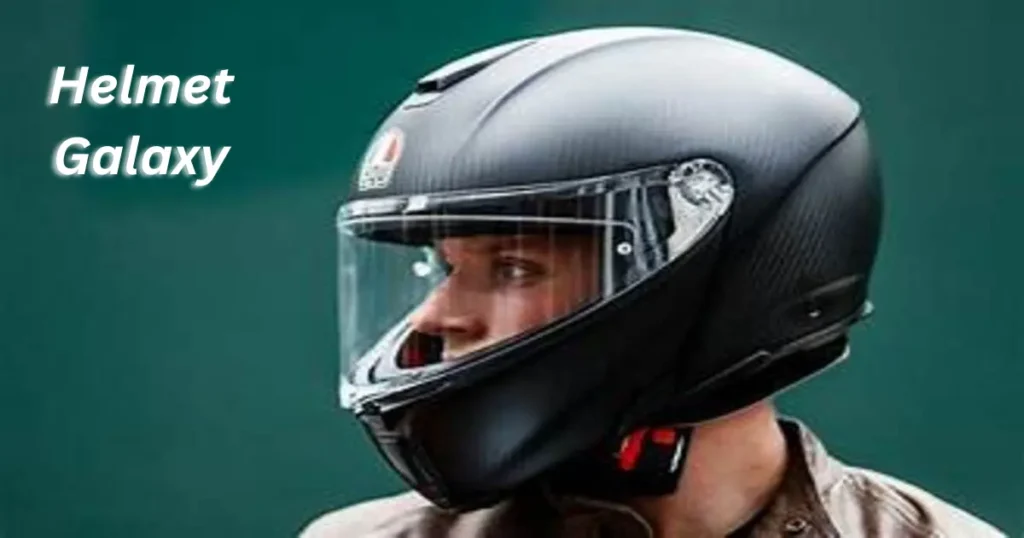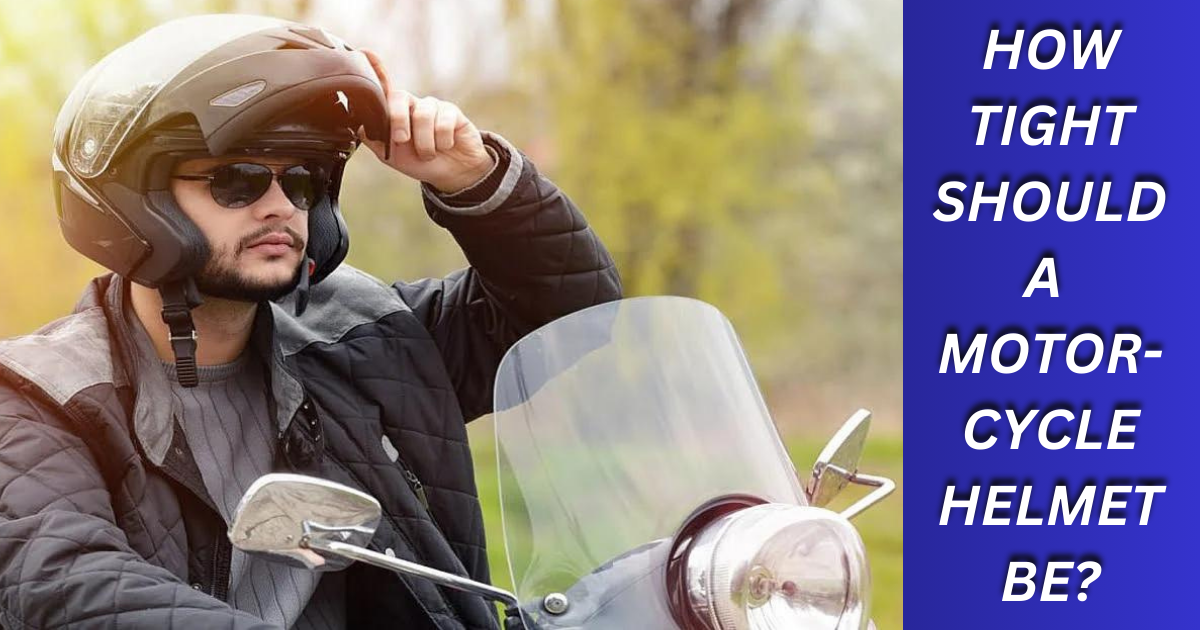A properly fitted motorcycle helmet should be snug but not painfully tight. Here are some tips on getting the right fit:
Check for pressure points
After putting on the helmet, check for any areas of excessive pressure. You should not feel any intense discomfort or pain from the helmet resting on your head. There may be some mild pressure around the forehead and cheek area, but this should not be excessive.
Shake the Motorcycle Helmet
Gently shake your head side to side and up and down. If the helmet shifts radically on your head or feels loose, it is too big. A properly fitted helmet should move just slightly.
Test the chin strap
Fasten the chin strap and open your mouth wide. This should cause the helmet to press down on the top of your head. If it doesn’t, the helmet is likely too big.
Consider sizing pads
Many helmets come with sizing pads that can be added or removed to get a custom fit. Consider using these to get the ideal snugness if the helmet is close to fitting properly.
Break-in period
It can take time for a new helmet to conform to your head shape. Expect it to fit snugly at first but to break in after 10-20 hours of wear. The fit may change slightly during this period.
Get professional help
If you are still unsure about the fit, visit your local motorcycle shop and ask for assistance. The sales staff can help you ensure a proper and safe fit.
How tight should the chin strap be?

The chin strap should be tight enough to keep the helmet securely on your head but not so tight that it’s uncomfortable. Here are some tips on adjusting chin strap tightness:
Only one finger space
There should only be enough room to slide one finger between the strap and your chin. If you can fit more than one finger, tighten the strap.
Check strap angle
The chin strap should form a V shape under your chin at a 45-degree angle on each side. This ensures an even distribution of tension.
Test with jaw movement
Open your mouth wide and move your jaw up and down. The helmet should pull down on your head. If it doesn’t, tighten the strap.
No skin folding
The strap should lie flat against your skin without causing folds or indentation. If you see skin bunching up, loosen the strap a bit.
Allow a little slack
Don’t tighten the strap so much that you feel like you’re choking. Leave just enough room so you can swallow comfortably.
Test shaking
Shake your head vigorously from side to side. If the helmet is loose enough to shift or slide, tighten the strap another notch.
Check buckle and strap condition
Examine the chin strap buckle and strap for signs of wear or fraying. Damaged parts can impact safety and fit. Replace them if needed.
What are the signs that a Motorcycle Helmet is too tight?

Riding with an overly tight Motorcycle Helmet can be painful and hazardous. Here are some signs that your helmet may be too tight:
Headache or neck ache
If you get a headache or neck ache from wearing your helmet, it is likely putting too much pressure on your head. This can cause muscle strain.
Discomfort around the crown
Sensitivity or soreness on the crown of your head can signal that the Motorcycle Helmet is cinched down too tightly.
Pain or numbness around the forehead
Excessive tightness pressing on the forehead area can irritate nerves and blood vessels, leading to localized pain or numbness.
Red indentations on the skin
Noticeable red lines or indentations on your skin after taking off your helmet indicate excess pressure on those spots.
Vision obstruction
If the cheek pads press your cheeks in tightly enough to compromise your peripheral vision, the helmet is too small.
Difficulty breathing
A helmet that is painfully tight can make it harder to draw full breaths. This impedes ventilation and oxygen flow.
Headache when shaking head
If shaking your head from side to side causes headache or dizziness, that level of G-force motion is unsafe in a too-tight helmet.
Skin irritation
Intense, long-term friction from an ill-fitting helmet can cause soreness, blisters, calluses or acne outbreaks on your head.
Tips for getting your helmet properly tight

Follow these tips to ensure your Motorcycle Helmet fits snugly but remains comfortable:
Start with correct size
First, confirm you are wearing the properly sized Motorcycle Helmet for your head’s circumference. This provides a baseline good fit.
Gradually tighten
Slowly tighten the chin strap over time, allowing your head and neck muscles to acclimate. Don’t cinch it down all at once.
Find pressure points
Wear the Motorcycle Helmet for short periods, feeling around for areas of excess pressure. Use sizing pads to relieve these spots.
Check fit each time
Before each ride, do the shake test and chin strap finger test to confirm a secure yet comfortable fit.
Maintain optimal position
Set the helmet so the front rim sits just above your eyebrows. Position the chin strap under your jaw correctly.
Loosen collar or scarf
Any clothing touching your neck can interfere with a proper helmet fit. Loosening them may help.
Maintain helmet and strap
Check for helmet liner deterioration and keep your chin strap clean and undamaged. Replace parts as needed.
Consider professional fitting
If you continue having fit issues, seek out a professional fitting at a specialty motorcycle shop. This is the best way to solve persistent problems.
Table comparing signs of a Motorcycle Helmet that is too loose versus too tight
| Helmet Too Loose | Helmet Too Tight | |-|-|-|
| Shifts around on head when shaking | Causes head or neck ache | | Slides down over eyes | Leaves red marks on skin |
| Needs frequent re-adjustment | Obstructs peripheral vision | | Chin strap can fit multiple fingers |
Causes difficulty breathing | | No resistance when opening mouth | Headache when shaking head | | Does not pull head when opening mouth | Causes skin irritation | |Makes rattling noise when shaking head | Feels painful on crown of head |
Conclusion
Finding the optimal motorcycle helmet fit involves balancing comfort and security. Follow the guidelines here regarding chin strap tightness, sizing pads, pressure point checks, and professional assistance if needed. Take the time to properly adjust and break in your helmet for the safest and most enjoyable riding experience.
Although a snug fit may feel restrictive at first, your safety depends on the integrity of your helmet’s fit. So be diligent about getting it right and checking it before every ride. Wearing a helmet should not be painful but you should feel it firmly gripping your head. With the right fit dialed in, you can enjoy the freedom of riding knowing impact protection surrounds you.
Frequently Asked Questions about Motorcycle Helmet Fit
Here are some common questions about how tight should a motorcycle helmet be:
How do I know when the helmet breaks in properly?
It usually takes 10-20 hours of riding for a new helmet to conform to your head shape. You’ll know it’s broken in when it feels secure but no longer causes any discomfort or pain pressure points. The fit may feel snug when first worn but should not cause headaches or skin irritation.
Should my cheeks touch the cheek pads?
Yes, the cheek pads should touch your cheeks without pressing painfully. They are designed to cradle your face to keep your head stable within the helmet. The cheek pads will conform to your face over time, but make sure they don’t obstruct your peripheral vision.
How often should I adjust and check the chin strap?
Check the tightness and angle of the chin strap before every ride. Because it can loosen over time, do a quick fingertip and shake test periodically while riding as well. Be prepared to stop and readjust if needed for safety.
What are sizing pads and how do I use them?
Sizing pads are thin foam rings that can be added or removed from a helmet to customize the fit. They are useful for relieving pressure points if the helmet is slightly too tight in localized areas. Consult your owner’s manual on properly inserting pads into the helmet liner.
Should I feel head pressure when properly fitted?
It is normal to feel mild pressure around the crown and forehead of a properly fitted helmet. The key is that this pressure should not cause discomfort or headache. There will be moderate resistance when sliding the helmet on and off.
When should I replace my helmet due to fit issues?
If your helmet has deteriorated and no longer holds a snug fit, or if foam padding has compressed so much that pressure points result, it’s time for a new helmet. Fit changes over years of use indicate expired safety.
What is the proper measuring technique for head size?
Wrap a flexible tape measure around your head just above your eyebrows and ears. Make sure the tape lies flat with equal tension all around your head. For accuracy, have someone else take the measurement. Compare the result in inches or centimeters to a sizing chart.
Can I put extra padding inside if my helmet is too loose?
No, you should never add extra padding or inserts beyond the manufacturer’s sizing pads. An oversized helmet requires smaller sizing pads or a smaller helmet. The safest approach is visiting a shop for professional fitting guidance.
How do I know if the cheek pads are too tight?
Cheek pads that obstruct peripheral vision, dig painfully into the sides of your face, or leave deep indents in your skin after removing the helmet are too tight.
How often should I clean the interior padding?
Regularly cleaning the liner and cheek pads is important to maintain proper fit and hygiene. Remove the padding and hand wash using mild soap and water every 1-2 weeks. Let the pads fully air dry before re-installing to prevent shrinkage.
Replace padding immediately if badly soiled or overly compressed. A helmet with deteriorated, flattened padding can’t provide its designed shock absorption and fit.
Will a helmet loosen up in the rain?
Most helmet materials will absorb some moisture in wet conditions, causing a slight loosening of the fit. Good-quality helmets designed for motorcycle use resist water saturation well. To limit loosening in the rain, apply a water-repellent finish and check your strap tightness more frequently.
How do I know when it’s time to replace my helmet?
Replace any helmet after 5-7 years due to material breakdown, even if no damage is visible.
Replace after any impact that caused your head to hit the inside, which compromises safety layers. Also replace if the exterior shows damage not just cosmetic scratches.
Replace when the fit is loose and degraded with age and use. Padding compresses permanently over time. A loose helmet provides less protection in a crash.
Can I adjust the visor for a tighter fit?
Loosening or removing the visor may seem like it gives a tighter fit, but this is unsafe. The visor is designed to press firmly against the brow for stability, vent airflow, and impact protection. Adjust only the chin and cheek straps for proper snugness.
Can I put on a beanie under the helmet for tighter fit?
Never wear additional headgear not made specifically for your helmet model. Beanies and caps can compromise the designed safety fit. They also absorb sweat and oils, affecting helmet hygiene. Use only approved extra liners from the manufacturer.
Will talking on my cellphone loosen my strap?
Using a cellphone while riding is not advisable for safety reasons. However, if necessary, use a helmet-compatible headset system. This allows you to talk hands-free without loosening the helmet to hold a phone to your ear. Maintain proper strap tightness at all times when riding.
Why do race helmets fit tighter?
Racing helmets are designed for extreme high-speed maneuvers and crashes. The ultra-snug fit creates a more stable, wobble-free enclosure for the head during violent maneuvers and impacts. For street use at lower speeds, such tightness is unnecessary and uncomfortable.
Can I adjust fit with aftermarket pads?
Only use replacement cheek and lining pads approved for your specific helmet model. Aftermarket pads may not match the safety specifications. Improper materials and fit can degrade protection. Consult your owner’s manual regarding approved replacement parts.
Should I feel jaw pressure when fully strapped?
Proper tightening will result in some firm pressure around the jawbone where the chin strap passes under it. But this should not cause acute discomfort. It ensures the jaw is stabilized, and the helmet won’t shift off your head in a fall.
